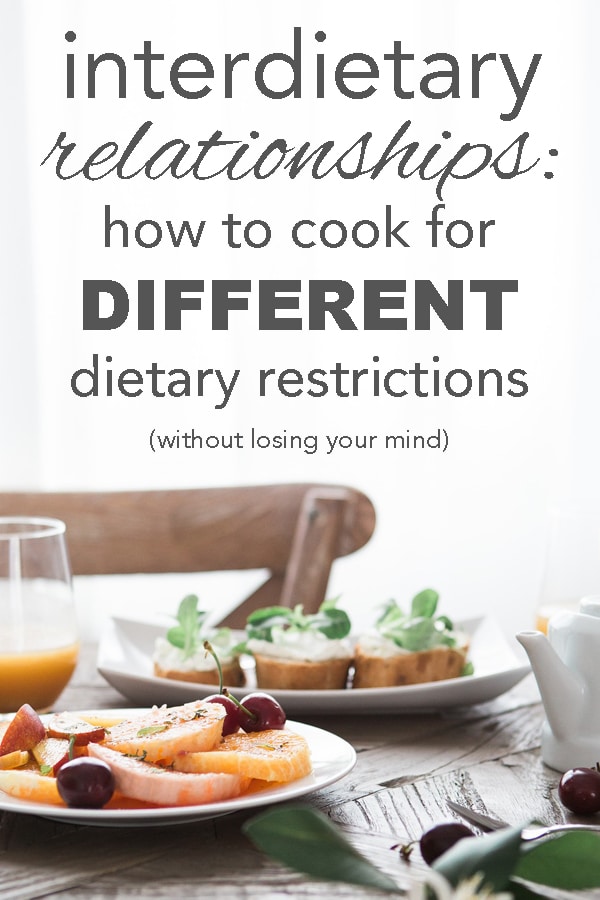Interdietary Relationships: How to Cook for Different Dietary Restrictions
Sustainable Relationships
February 17, 2017 | Kathryn Kellogg
Last Updated on January 23, 2024
You’re a vegetarian, your partner was raised meat and potatoes (and not changing anytime soon), your son has a peanut allergy and your daughter is allergic to dairy. How do accommodate all of these different dietary restrictions without losing your mind?

How do you do it without cooking four different meals? Which sounds absolutely exhausting by the way. I could definitely see the appeal of eating out, but man that would get expensive.
Plus you really wouldn’t have control of what you were eating or the amount of waste being produced. Growing up allergic to dairy and now not eating meat, I have always had dietary restrictions.
Justin is a pretty picky eater. He was raised meat and potatoes, and I avoid meat and dairy. As you can see, we have a dietary gap.
related: The Ultimate Guide to Zero Waste Grocery Shopping
Sitting down to a shared meal is something very important to me. Eating good, wholesome food is really important to me too. I don’t want to spend hours in the kitchen making two separate meals, so I had to learn how to make us both happy, full, and nourished.
That is something I refuse to compromise on… so here it is the ONE and only rule for making interdietary relationships work effortlessly.
It’s so simple. After you read it, you’re going to be like, “Why is this so obvious!? Why haven’t I implemented this before?”
Table of Contents
“the base of the meal should be something you both can eat, garnish with preference.”
Boom.
Life changing.
No lie.
I have a list of a whole bunch of meals we both like on my five-minute meal plan post. Which you should definitely check out. (It’s a completely different way to meal plan based on frequency of cravings.)
related: Dating with Lifestyle Differences
1. agree on flavor preference:
Justin doesn’t particularly like Indian or Thai food. I LOVE both especially because they so easily lend themselves to vegetarian and dairy free. He prefers Italian and American food. Both of those are very dairy and meat heavy.
But, we can always meet in the middle over Mexican food. It’s definitely tex mex, but why does this combo work so well?
2. use the same base:
It works so well because our main components of the cuisine are the same. We can both agree on beans, rice, and tortillas.
3. garnish with preference:
Here’s where you get to be creative. Let’s say we’re making tacos. I’ll sautee some bell peppers, mushrooms, onions, and garlic in the skillet. After they’ve finished, I’ll add in some ground beef and sprinkle with a little bit of cheese.
Justin will get a little bit of veggies, the meat and the cheese. I’ll get a WHOLE bunch of veggies. Just the way I like it. We’ll both top with plenty of guac and salsa.
We both have something we love to eat in a timely manner. Sometimes, I bring out the big 15″ skillet and do half and half on the skillet to save time.
4. other examples:
Here’s a list of some other things we like to make if you’re looking for inspiration.
Spaghetti is the easiest. We can easily agree on a base of sauteed mushrooms, spinach, and garlic. Add parm and a little ground beef for him.
Chicken parm for him and eggplant parm (without the parm) for me! The same steps are happening with the breading, frying, and saucing. It only takes probably a minute more to slice the eggplant.
We both love fried rice. It can easily be packed full of veggies. We both like eggs, so this is perfect for us.
Sometimes, you find really great recipes that work for everyone, but it’s not a dealbreaker if you don’t.
By using this method and changing garnishes, you’re not severely limiting yourself to only the recipes you both like. If that were the case, we’d eat nothing but PB&J and fried rice.
It’s not that Justin has to have meat or dairy, but it can be difficult to find recipes that he really likes that don’t involve those ingredients.
By making the same bases and changing the garnishes, we’re eating a fuller diet. He’s eating more vegetables and less meat and dairy. Which is great for the environment and our health. Wins all the way around!
Are you in an interdietary relationship? What are some of the meals you can agree on?










Does Justin do any cooking at all?
He does, but it’s meat and potatoes. He won’t make any vegetables. 😉
I don’t eat meat but my partner does, but he was a vegetarian for years and has no qualms about eating a vegetarian diet at home (but obviously if he wanted to eat meat at home I wouldn’t stop him!). So he only eats meat when we eat out, which is a good balance I think. But, I realise that wouldn’t work for everyone, I think as far as interdisciplinary diets go I’m pretty lucky that ours is easy, although I think it would be a different story if I stopped eating dairy which I sometimes consider.
I find it really interesting that you cook meat and veg in the same pan though. When I stopped eating meat two years ago I thought that sort of thing wouldn’t bother me, but it kind of does. But maybe it wouldn’t if I did cook meat at home? I guess as you say, there’s an element of not wanting to unnecessarily create more work for yourself!
I think it’s a mindset thing. I also was raised cooking and eating meat. If dairy touches my food, I will become violently ill and it will be exceedingly difficult to breathe. If meat touches my food, nothing happens. So, I don’t really care, as long as I’m breathing. I have a little bit different frame of reference. 😉 I used to feel highly uncomfortable having any dairy in the the house at all. But, I’ve gotten used to it.
I’m vegan and my boyfriend is vegetarian, but he is happy to eat the vegan meals I make or cook vegan recipes when he’s cooking for both of us. Before we started started dating he ate more animal products, and I think it’s great how earth friendly diets like veganism and vegetarianism can spread in couples, families, and communities. A similar thing happened with my parents, who were super supportive of my going vegan and in the process learned a lot of vegan recipes they now regularly eat. Yay for animals, yay for the planet!
That’s so awesome to hear! Positive changes for the well being of others like animals and the planet typically have positive changes in our health as well. People can’t help but be curious, if you’re nice about it. 🙂 🙂
For me the harder part would be about the moral values. I don’t think I could be with someone who supports the meat and dairy industries because that is the main reason I don’t eat those foods.
I addressed this thoroughly in my facebook post about this. Justin and I have been together long before I went zero waste or cut out meat products. It would be stupid to dump him over changes I wanted to make. I can understand not being in a relationship and looking for a partner with similar lifestyle and outlook, but dumping someone over it seems absurd. Especially, when you have years of history and you love them for who they are not what they eat.
I am vegan, my boyfriend is a meat and dairy eater. We both cook, although I do more often. Most of the meals are vegan, but I often make something that can be transformed from vegan to non vegan: miso soup with noodles – he will add an egg; homemade pizza – there will be cheese on his half; avocado sandwiches- eggs again. He usually only eats meat when we go out and is completely fine with it. Also, having a non-vegan cook for me is great, because he comes up with new combinations and dishes.
Those are all great meal ideas! And, now I really want an avocado sandwich. 🙂
Great tips, love the idea of finding a flavor you can both agree on. I have found lots of common ground with avocado toast, mushroom stir fry on top of pasta (add meat separately or kale separately), almost any soup, and garlic bread. Also the middle eastern seasoning zaatar has brought us together– add it to everything.
These are good tips for picky kids too. Homemade or mini Pizzas with different toppings to suit each family member or diy tacos or fried rice bowls. Growing up, my mom would make one main dish and fix sides separately. I didn’t like peas, so when she made peas she would also make another veggie to keep everyone happy and nourished without catering too much to the individual. I plan to treat my kiddo similarly.
I have enjoyed following all of your posts! And with going minimal waste a year and a half ago I’m still having a hard time with my meat products, specifically the raw (and cooked) meat portions that do not get eaten, that I cut off…I will freeze it and add to my bone broth but then after that I am still left with it and it gets thrown away. Any ideas or ways in which you discard of the meat that is not consumed?
Thanks!!
Really healthy tips to cook. I have diabetes from past two years and i have to think many times before eating anything. Your blog is very helpful. Now I can cook anything for me which will be healthy. Thanks for sharing such a nice recipe. Please bring some more vegan food recipes.
<a href="http://www.wildsunflowerchef.com">vegan food recipes</a>
I like cooking tips and tricks.
I can handle most the zw changes I’ve made untill it comes to cooking. When you have a toddler thats a fussy eater and a husband that can be just as bad it make it difficult for me.